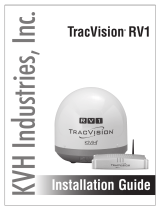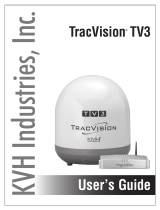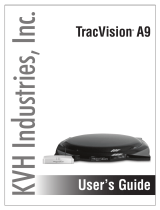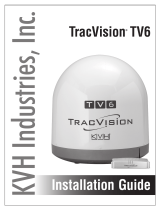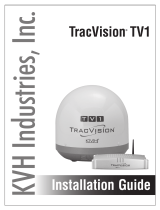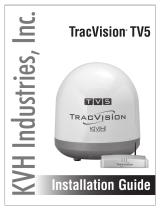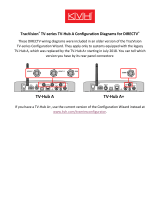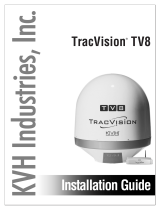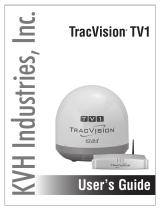Page is loading ...

KVH Industries, Inc.
Installation Guide
TracVision
®
TV3

TracVision TV3 Installation Guide
1
KVH, TracVision, and the unique light-colored dome with dark contrasting baseplate are registered trademarks of
KVH Industries, Inc. All other trademarks are property of their respective companies. The information in this document is subject
to change without notice. No company shall be liable for errors contained herein. © 2014 KVH Industries, Inc., All rights reserved.
54-0978 Rev. A
This guide explains how to install the TracVision TV3 satellite TV antenna system on a vessel.
Operation instructions are provided in the Quick Start Guide.
Installation Steps
Appendices
Who Should Install the System?
To ensure a safe and effective installation, KVH recommends that a KVH-authorized marine
technician install the TracVision antenna. KVH-authorized technicians have the tools and
electronics expertise necessary to install the system. To find a technician near you, visit
www.kvh.com/wheretogetservice.
Technical Support
If you need technical assistance, please contact KVH Technical Support:
1. Inspect Parts and Get Tools .................... 3
2. Plan the Antenna Installation................. 4
3. Plan the TV-Hub Installation.................. 5
4. Prepare the Antenna Site......................... 6
5. Prepare the RF Cables.............................. 7
6. Wire the Antenna ..................................... 8
7. Remove the Shipping Restraint.............. 9
8. Mount the Antenna................................ 10
9. Mount the TV-Hub................................. 11
10. Wire the TV-Hub.................................... 12
11. Wire the Receivers.................................. 13
12. Connect a NMEA Device ...................... 18
13. Connect to a Network............................ 19
14. Secure the Wi-Fi Connection ................ 20
15. Connect Power........................................ 21
16. Turn On the System ............................... 23
17. Set Up the System................................... 24
18. Set the LNB Skew Angle ....................... 28
19. Educate the Customer............................ 29
A. Wiring Diagrams..................................30 B. Connecting IP AutoSwitches..............35
Europe, Middle East, Africa, Asia-Pacific
Phone: +45 45 160 180
E-mail: [email protected]
(Mon.-Thu., 8 am-4:30 pm, +1 GMT)
(Fri., 8 am-2 pm, +1 GMT)
North/South America, Australasia
Phone: +1 401 847-3327
E-mail: [email protected]
(Mon.-Fri., 9 am-6 pm ET, -5 GMT)
(Sat., 9 am-2 pm ET, -5 GMT)

2
This icon indicates a danger, warning, or caution notice. Be sure to read these carefully to avoid
injury.
WARNING
Risk of Electric Shock
To avoid electric shock, do not open the TV-Hub chassis enclosure. There are no user-serviceable parts
inside.
WARNING
Risk of Electric Shock
If any component of the TracVision system becomes damaged and/or no longer functions normally,
disconnect it from vessel power, secure it from unintended operation, and contact KVH Technical
Support (see “Technical Support” on page 1). All repairs or modifications must be performed by a
trained, KVH-certified technician. If you are a KVH-certified technician, you still must contact KVH
Technical Support prior to conducting any repairs or modifications to the equipment.
WARNING
Risk of Explosion
Do not operate the TV-Hub (or any other electrical device) in an environment where flammable gases,
vapors, or dusts are present. In addition, do not operate the TV-Hub in an environment with a
temperature outside its 5º F to 131º F (-15º C to 55º C) temperature range.
WARNING
Risk of Electric Shock
Failure to ground the TracVision system properly to ship’s ground will cause an unsafe floating
ground condition, risking potentially lethal electric shock. See “Connect Power” on page 21 for details
on the proper grounding of the equipment.
Important Safety Information

3
Before you begin, follow the steps below to ensure
you have everything needed to complete the
installation.
a. Unpack the box and ensure it contains everything
shown on the Kitpack Contents List. Save the
packaging for future use.
b. Carefully examine all of the supplied parts to
ensure nothing was damaged in shipment.
c. Gather the tools and materials listed below. You
will need these items to complete the installation.
• Flat-head and Phillips-head screwdrivers
• Electric drill and 5/16" (8 mm) and
1/8" (3 mm) drill bits
• 3" (80 mm) hole saw
•10 mm socket wrench
• 7/16" open-end torque wrench set to
20 in.-lbs (2.25 N-m)
• 7/16" open-end torque wrench set to
15 in.-lbs (1.7 N-m)
• Torque wrench and 2 mm Allen hex key
• Light hammer and center punch, adhesive
tape, and scriber or pencil
• RG-6 or RG-11 RF coax cable(s), with “F”
connectors, and termination tools (see page 7)
• Silicone sealant or equivalent
• Satellite TV receiver(s)/DVRs for your desired
service (see Figure 2)
• Wi-Fi-enabled laptop PC with the latest
TracVision software and satellite library
downloaded from the KVH Partner portal
(www.kvh.com/partners), or
iPhone
®
/iPad
®
with the latest downloads
through the TracVision TV/RV App
Always lift the antenna by the baseplate and
never by the radome or any portion of the
internal antenna assembly (see Figure 1).
Antenna
TV-Hub
Radome
Baseplate
Figure 1: TracVision TV3 System Components
Figure 2: KVH-Validated Receivers
* List is subject to change. For information on connecting different
receiver models, contact KVH Technical Support.
Linear
For information on the recommended
receivers for linear service, contact your local
KVH dealer/distributor. Go to
www.kvh.com/wheretogetservice to find a
dealer/distributor near you.
DIRECTV*
DISH Network*
H20
H21
H22
H23
H24
H25
HR21, HR21 Pro
HH22
HR23
HR24
HR34
HR44
311
211
211k
211z
Bell TV*
6100
6131
6400
Inspect Parts and Get Tools
1
IMPORTANT!

4
Before you begin, consider the following antenna
installation guidelines.
• Minimize blockage. The antenna requires a
clear view of the sky to receive satellite TV
(see Figure 3). The fewer obstructions, the
better the system will perform.
• KVH requires that you do not mount the
antenna on the same level as the radar,
because the radar’s energy may damage the
LNB. Ideally, you should mount the antenna
3 ft (1 m) away from and above or below the
15º radar beam path (see Figure 4).
• Make sure the mounting surface is wide
enough to accommodate the antenna’s base
(see Figure 5). Also make sure it is flat, level
(within ±1°), strong enough to support the
antenna’s weight, and rigid enough to
prevent antenna vibration.
• Select a location that is as close as possible to
the intersection of the vessel’s fore-and-aft
centerline and midships.
• Be sure to mount the antenna near enough to
the TV-Hub to allow you to connect the 50 ft
(15 m) coax cable between them, while still
maintaining sufficient slack in the cable.
NOTE: If you need to use a longer cable, use an RG-6
(75 ) cable that does not exceed 100 ft (30 m) in
length, or an RG11 (75 ) cable that does not exceed
200 ft (60 m) in length (see “Prepare the RF Cables”
on page 7).
Be sure to follow the guidelines below.
Damage caused by an improper installation is
not covered under KVH warranty.
IMPORTANT!
Blocked!
TracVision Antenna
Mast
Look Angle
Vessel Platform
10° to 80°
Figure 3: Blockage from Obstruction
+15°
-15°
3 ft (1 m)
Minimum
Radar
Figure 4: Distance from Radar
15.5"
(39.4 cm)
17.6"
(44.7 cm)
4 x ø0.3"
(ø0.8 cm)
9.2"
(23.4 cm)
4.6"
(11.7 cm)
2.8"
(7.1 cm)
5.6"
(14.2 cm)
Cable Connector
Side View
Bottom View
Cable Connectors
Dual Linear
Figure 5: Antenna Dimensions
Plan the Antenna Installation
2

5
Consider the following TV-Hub installation
guidelines.
• Select a mounting location in a dry, well-
ventilated area belowdecks away from any
heat sources or salt spray.
• Do not install the TV-Hub in an area
surrounded by metal or near any electrical
devices that emit RF noise.
• The TV-Hub can be mounted horizontally or
vertically on a flat surface (see Figure 6 and
Figure 7). This includes mounting on a ceiling
or in a rack.
• Ideally, the TV-Hub LED lights will be easily
visible to the user.
• Select a location that will provide adequate
clearance for the TV-Hub dimensions (see
Figure 6 and Figure 7).
• Leave enough room behind the rear panel
(horizontal mount) or below the rear panel
(vertical mount) to accommodate connecting
the cables and making service loops within
the proper bend radius.
• If you plan to use the TV-Hub’s Wi-Fi
connection, ensure the TV-Hub mounting
location provides adequate Wi-Fi reception.
• If you plan to connect the TV-Hub to the
vessel LAN, choose a location that takes
Ethernet connection into consideration.
NOTE: A template showing the exact locations of the
TV-Hub mounting holes and the dimensions between
them is provided in the Welcome Kit. Installation
details are provided in “Mount the TV-Hub” on
page 11.
1.73"
(4.4 cm)
9.34"
(23.7 cm)
4.36"
(11.1 cm)
7.90"
(20.0 cm)
LED Lights
Figure 6: TV-Hub Dimensions - Horizontal Orientation
Top View
9.34"
(23.7 cm)
10.94"
(27.8 cm)
10.52"
(26.7 cm)
7.90"
(20.0 cm)
LED Lights
Figure 7: TV-Hub Dimensions - Vertical Orientation
Plan the TV-Hub Installation
3

6
Once you have identified a suitable antenna
mounting site, according to the guidelines
provided on page 4, follow these steps to drill the
mounting holes and cable access hole to prepare
the site for installation.
a. Unfold the antenna mounting template
(supplied in the Customer Welcome Kit) and
place it onto the mounting surface. Make sure
the “FWD” (forward) arrow points toward the
bow and is parallel to the vessel’s centerline
(see Figure 8). Tape in place.
NOTE: You don’t need to mount the antenna exactly
on the vessel’s centerline (the closer, the better), but the
antenna’s forward arrow must be parallel to it.
b. Using the template and a light hammer and
center punch, mark the locations for the four
mounting holes.
c. Drill a 5/16" (8 mm) hole at the four mounting
hole locations you marked in Step b. Later, you
will insert four 1/4"-20 bolts through these
holes to secure the antenna to the mounting
surface.
d. Mark a location for the cable access hole, either
in the center of the antenna mounting hole
pattern or in an area aft of the antenna. Later,
you will route the antenna cable through this
hole and into the vessel.
e. Using a hole saw, drill the cable access hole in
the location you marked in Step d. Be sure to
size the hole approximately to maintain a cable
bend radius of at least 3" (75 mm). If the hole
location is in the center of the antenna
mounting hole pattern, the diameter of the
cable access hole must not exceed 3.5" (88 mm).
Smooth the edges of the hole to protect the
cables. Later, you will route the RF cable(s)
through this hole and into the vessel.
f. Clean and dry the antenna mounting surface.
g. Peel off the paper backing from the supplied
foam seal to expose the adhesive. Then press
the foam seal down firmly onto the mounting
surface, centered between the antenna
mounting holes (see Figure 9).
X
15.5"
(39.4 cm)
2.8"
(7.1 cm)
5.6"
(14.2 cm)
4.6" (11.7 cm)
9.2"
(23.4 cm)
4 x Ø 5/16"
(Ø 8 mm)
Mounting Holes
Cable Access Hole
(Suggested)
Antenna Base
Figure 8: Antenna Mounting Holes Layout
Center
Between
Mounting
Holes
Figure 9: Foam Seal
Prepare the Antenna Site
4

7
Follow the steps below before you begin wiring
the antenna.
a. Determine the number of RF coax cables you
need to connect to the antenna for your
particular installation (see Figure 10).
NOTE: A system with a dual linear LNB requires
an additional 50 ft (15 m) RG-6 RF cable with a
sealing boot (KVH part no. 32-0819-50). Spare
right-angle connectors and right-angle boot
extensions are supplied in the kit.
b. Determine the type of RF cable(s) and
connectors required for any RF cables
required in addition to what is supplied in
the antenna kit (see Figure 11). Then follow
the guidelines below to select and prepare the
antenna’s RF cable(s).
Figure 10: Number of RF Coax Cables to Connect to Antenna
* Multiswitch may be required.
Connecting to: RF Cables
System with Circular LNB
1 receiver 1
2 or more receivers 1*
System with Single Linear LNB
1 receiver 1
System with Dual Linear LNB
2 receivers 2
Note: LMR-400-75 is a suitable substitute.
Up to 100 ft (30 m) Cable Run
Cable RG-6
(KVH part no. 32-0417-0100)
Connector Thomas & Betts SNS1P6
(KVH part no. 23-0170)
Tools Augat IT1000
(KVH part no. 19-0242)
Strip
Lengths
Up to 200 ft (60 m) Cable Run
Cable RG-11
(KVH part no. 32-0566-0200)
Connector Thomas & Betts SNS11AS
(KVH part no. 23-0213)
Tools Thomas & Betts CST596711,
L3011B (KVH part no. 72-0493)
Strip
Lengths
0.25" (6.35 mm)
0.5" (12.7 mm)
0.064" (1.63 mm) dia.
0.25" (6.35 mm)
0.5" (12.7 mm)
0.064" (1.63 mm) dia.
Figure 11: RF Cable Requirements
• RF cables must be rated for 75not 50
• Use of any cables not specified in
Figure 11 will void the warranty.
• Low-quality, poorly terminated, or
improperly installed RF cables are the
most common cause of system problems.
Terminate all RF cables with high-quality
“F” connectors using the proper
stripping/crimping tools, exactly to the
manufacturer’s specifications.
• When determining cable lengths, be sure
to account for an adequate service loop,
approximately 8" (20 cm) at both ends of
each cable.
IMPORTANT!
Prepare the RF Cables
5

8
Follow the steps below to wire the antenna.
a. Using the supplied 3 mm Allen hex key,
remove the connector cover from the
antenna’s base (see Figure 12). Save the cover
and the four M4 cap screws for later use.
b. Route the antenna cable belowdecks through
the cable access hole, keeping the end of the
cable with the rubber sealing boot, shown in
Figure 13, at the antenna site. Leave an
adequate service loop, approximately
8" (20 cm) of slack, in the cables for
serviceability.
NOTE: If you are routing the cable underneath the
antenna, add a right angle connector and a right-angle
boot extension onto the cable as shown in Figure 13.
c. Clean and dry the connectors on the RF
cable(s) and the underside of the antenna.
d. Fill half of the inner body of an RF cable’s
connector with the supplied silicone grease.
e. Connect and SLOWLY hand-tighten the RF
cable to the “RF1” connector on the bottom of
the antenna (for a dual linear TV3, see
Figure 14 for the RF1 connector location),
allowing the grease to diffuse and settle into
the entire space within the connector.
f. Make sure the RF cable is tightened all the
way into the connector. Then tighten it with a
7/16" torque wrench set to 20 in-lbs, or a
7/16" wrench for 1/4 turn.
g. Wipe off any excess grease from the outside
of the connector.
h. Mate the boot to the RF connector or boot
extension covering the right-angle connector.
i. If the antenna is a dual linear TV3, label both
ends of each cable and repeat steps b through
h to connect the second RF cable to the
antenna’s “RF2” connector.
j. Seal the RF cable connections with silicone
sealant or equivalent.
k. Weatherproof and seal the cable access hole
as required.
l. Reinstall the connector cover.
Figure 12: Removing the Connector Cover
Right-Angle
Connector
Right-Angle
Boot Extension
Rubber
Sealing Boot
Figure 13: Rubber Boot Extension for Right-Angle Connector
RF1 ConnectorRF2 Connector
Figure 14: Connectors on Bottom of Dual Linear Antenna
Wire the Antenna
6

9
Inside the antenna, a shipping restraint prevents
the antenna assembly from moving during
shipment. Follow these steps to remove this
restraint.
a. Remove the three #10-32 Phillips screws
securing the radome to the baseplate (see
Figure 15). Carefully lift the radome straight
up until clear of the antenna assembly and set
it aside in a safe place.
TIP: If you keep the radome topside, secure it with a
lanyard to prevent it from falling overboard. Also, do
not place the radome on a hot steel deck – the heat may
warp the radome.
b. Using a 10 mm socket wrench, remove the
bolt, washer, tag, and spacer securing the
antenna assembly to the baseplate (see
Figure 16). Save this hardware for future use.
#10-32 Screw (x3)
Figure 15: Removing the Radome
Bolt
Washer
Tag
Spacer
Figure 16: Shipping Restraint Hardware
Once you have removed the restraint, keep
the antenna level as much as possible and
handle the antenna very carefully. Prevent
the internal antenna assembly from rotating
freely within the baseplate to avoid damaging
the limit switch.
IMPORTANT!
Remove the Shipping Restraint
7

10
Follow these steps to mount the antenna to the
mounting surface.
a. Place the antenna baseplate over the holes
drilled in the mounting surface. Ensure the
“Forward” arrow inside the baseplate points
toward the bow and is parallel to the vessel’s
centerline (see Figure 17). The antenna’s base
should rest squarely atop the foam seal.
b. Apply a thin layer of the supplied anti-seize
lubricant to the threads of the four 1/4"-20
mounting bolts.
c. Secure the antenna’s base to the mounting
surface using four 1/4"-20 bolts, 5/8" washers,
1" washers, and 1/4"-20 lock nuts (see
Figure 18).
d. Tighten all four bolts until the four rubber feet
on the baseplate are bottomed against the
mounting surface and the foam seal is fully
compressed.
e. Reinstall the radome onto the antenna. Secure
in place with the three #10-32 screws you
removed on page 9.
f. Install a protective plastic screw cap (supplied
in the kitpack) over each radome screw.
CAUTION
Observe the safety warnings printed on the
tube of Loctite
®
anti-seize lubricant:
“Contains mineral oil, calcium hydroxide,
and copper. May cause skin, eye, and
respiratory irritation. Wear eye protection
and gloves. First aid: In case of eye or skin
contact, flush with water. Obtain medical
attention for any eye or internal contact.”
Figure 17: Forward Arrow in Antenna Baseplate
You will need to rotate the antenna assembly
by hand to see all four mounting holes. Rotate
the antenna assembly slowly. If it hits a
mechanical stop with excessive force, the
limit switch might become damaged.
IMPORTANT!
1/4"-20 x 3" Bolt
1/4" Flat Washer
(5/8" diameter)
Antenna Base
Foam Seal
Mounting Surface
1/4"-20 Lock Nut
1/4" Flat Washer
(1" diameter)
IMPORTANT:
Apply anti-seize
to threads
Figure 18: Mounting the Antenna (Side View)
Mount the Antenna
8

11
Follow these steps to install the TV-Hub inside
the vessel:
a. Tape the mounting template in the location
selected for the TV-Hub. Punch holes at each
of the two keyhole locations and at the
mounting tab location.
b. Remove the template.
c. Drill a 1/8" (3 mm) hole at the three hole
locations you marked in Step a.
d. Install a #8 Phillips thread-forming screw
partway into one of the keyhole holes leaving
a small gap for hooking the TV-Hub onto it.
Use the thickness (2.5 mm) of the M10 washer
supplied in the kit as a gauge for the size gap
to leave.
e. Repeat step d for the other keyhole.
f. Peel off the backing on the adhesive-backed
washer (supplied in the kit) and place it over
the mounting tab hole (see Figure 19).
g. Align the wide part of the TV-Hub’s
keyholes, as shown in Figure 20, over the
screws, then slide downwards to secure the
screws into the narrow part of the keyholes.
h. Press the rear mounting tab of the TV-Hub
onto the adhesive washer and install the third
#8 Phillips thread-forming screw in the
mounting tab hole.
7.93"
(20.1 cm)
2 x Ø 0.13"
(Ø 0.3 cm)
3.17"
(8.1 cm)
4.86"
(12.3 cm)
Front of TV-Hub
Keyhole
Ø 0.13"
(Ø 0.3 cm)
Mounting Tab
Figure 19: TV-Hub Mounting Template
Keyhole (x2)
Mounting Tab
Figure 20: TV-Hub Keyholes and Mounting Tab
Mount the TV-Hub
9

12
Follow these steps to wire the TV-Hub.
Antenna
a. Connect the RF1 cable from the antenna to
the “Antenna” jack on the TV-Hub (see
Figure 21).
b. Hand-tighten the RF cable until it is all the
way into the “Antenna” jack. Then tighten it
with a 7/16" torque wrench to 15 in-lbs, or a
7/16" wrench for 1/8 turn.
The wiring of any additional RF cables in the
configuration is covered in the receiver wiring
section (see page 13).
Receiver(s)
Connecting the TV-Hub to the system receiver(s),
and setting up the receivers according to the
system configuration depends upon the satellite
television service being used (see Figure 22 and
Figure 23). Detailed instructions are provided in
the next section.
NOTE: The wiring for other optional system
components follows this section. Proper grounding
and power wiring is described in “Connect Power” on
page 21.
10-30VDC IN
To antenna only
Deck
Antenna
RF2 for TV3
dual linear
RF1
Antenna
Figure 21: TV-Hub Antenna Connection
Do not connect anything other than the
antenna to the “Antenna” jack. The
“Antenna” jack has 42 VDC on it which will
damage other devices such as multiswitches,
DVRs, etc.
IMPORTANT!
10-30VDC IN
TV-Hub A
DIRECTV U.S.
Non-SWM Receivers
DISH Network, Bell TV,
and Linear Receivers
DIRECTV U.S.
SWM Receivers
Figure 22: TV-Hub A Receiver Connections
10-30VDC IN
TV-Hub B
Linear Receivers
Figure 23: TV-Hub B Receiver Connections
Wire the TV-Hub
10

13
Follow these steps to wire the receivers for the
associated satellite service, then connect the
receiver(s) to the customer’s television(s).
Linear. . . . . . . . . . . . . . . . . . . . . . . . page 13
DIRECTV. . . . . . . . . . . . . . . . . . . . . page 14
DISH Network/Bell TV . . . . . . . . page 17
Linear Configuration Wiring
Follow the steps below to wire the receivers in a
linear configuration.
Connecting 1 Receiver
Connect an RF cable from the “Receiver” jack on
the back of the TV-Hub to the “Satellite In”
connector of the receiver.
Connecting 2 Receivers (TV3 Dual Linear)
a. Connect each RF cable coming from the
antenna to a grounding block belowdecks
(see “Grounding Requirements” on page 21).
b. Connect an RF cable from the RF1 grounding
block position to the “Antenna” jack on the
TV-Hub.
c. Connect an RF cable from the “Receiver” jack
on the back of the TV-Hub to the “Satellite
In” connector of the first receiver.
d. Connect an RF cable from the RF2 grounding
block position to the “Satellite In” connector
of the second receiver (see Figure 24).
TV-Hub
Receiver
AC Power
Satellite In
Grounding Block
Antenna
Receiver
AC Power
Satellite In
Receiver
RF1
RF2
Figure 24: Wiring a 2-Receiver Linear Configuration
If you want to enable the second receiver to
control satellite selection, install an optional
IP AutoSwitch (KVH part no. 72-0634) inline
with the RF input to the receiver. Refer to
Appendix B, page 35 for details.
IMPORTANT!
Wire the Receivers
11

14
DIRECTV – SWM Wiring
Follow the steps below to wire a DIRECTV
system that includes SWM receivers.
Connecting 1 Receiver
Connect an RF cable from the “SWM” jack on the
TV-Hub to the “Satellite In” jack on the receiver/
DVR as shown in Figure 25.
Connecting 2-8 Receivers
Configurations for connecting multiple receivers
include a SWM splitter that supports up to 8
tuners.
Refer to Figure 26 to determine the tuners
consumed by each type of SWM component.
Refer to wiring diagrams in Appendix A for
connecting multiple SWM receivers and
connecting a network for autoswitching (see
page 30), and wiring for Genie devices (see page
31).
Wire the system as follows:
a. Connect an RF cable from the “SWM” jack on
the back of the TV-Hub to the “SWM” port on
the SWM splitter.
b. Connect an RF cable to each port of the SWM
splitter required by the configuration, and
connect its other end to the “Satellite In”
connector on the receiver/DVR, or
“Network” port when connecting a Genie
client.
c. Terminate any unused connectors on the
splitter with a supplied 75terminator.
d. Connect the TV-Hub and each receiver you
want to control satellite selection to the
vessel’s network. If a network is not
available, manual switching with a mobile
device is an alternative.
TV-Hub
AC Power
SWM Receiver/DVR
Satellite In
Antenna
RF1
SWM
Figure 25: DIRECTV SWM Wiring for 1 Receiver
Figure 26: Tuners per DIRECTV SWM Device
* Genie clients cannot switch satellites. Clients can view
programming carried on the satellite currently selected by the current
master receiver.
Device Tuners
Non-Genie SWM receiver 1
Non-Genie SWM DVR 2
Genie
™
DVR
5
(2 for its DVR, 3
shared with clients)
Genie client* None
Continued Wire the Receivers
11

15
DIRECTV – Non-SWM Wiring
Follow the steps below to wire a DIRECTV
system that includes non-SWM receivers.
Connecting 1-2 Receivers
a. Connect an RF cable from the “Legacy 1” jack
on the back of the TV-Hub to the “Satellite
In” jack on the receiver.
b. When installing 2 receivers, repeat step a
connect an RF cable from the “Legacy 2” jack
on the back of the TV-Hub to the “Satellite
In” jack on the second receiver (see
Figure 27).
Connecting 2-8 Receivers
Configurations for connecting multiple non-
SWM receivers include two DC block splitters
and require a 4 x 8 multiswitch (customer-
supplied or KVH part no 19-0573). See Appendix
A, page 32, for a wiring diagram for this
configuration.
Wire the system as follows:
a. Connect an RF cable from the “Legacy 1” jack
on the back of the TV-Hub to the “Antenna”
port on one of the DC block splitters.
b. Connect the “Primary” connector on the DC
block splitter to the “18V” connector on the
multiswitch, and connect the “Secondary”
connector on the splitter to the “18V/22KHz”
connector.
c. Repeat steps a and b with “Legacy 2” and the
second DC block splitter using the “13V” and
“13V/22KHz” connectors on the multiswitch.
d. Connect the multiswitch outputs to the
“Satellite In” jacks on the non-SWM
receivers.
e. Terminate any unused connectors on the
splitter with a supplied 75terminator.
NOTE: Non-SWM receivers are limited to manual
switching. See Appendix A, page 32, for the wiring
diagram for this configuration.
TV-Hub
Non-SWM Receiver
AC Powe
r
Satellite In
Non-SWM Receiver
AC Powe
r
Satellite In
Legacy 2
Legacy 1
Antenna
RF1
Figure 27: DIRECTV Non-SWM Wiring for 1 or 2 Receivers
Continued Wire the Receivers
11

16
DIRECTV – SWM and Non-SWM Wiring
To wire a DIRECTV system that includes both
SWM and non-SWM receivers, refer to the
diagram shown in Figure 28 and the individual
SWM and non-SWM instructions provided on
the previous pages.
NOTE: See “DIRECTV SWM and Non-SWM
Configuration” on page 33 for another example
wiring diagram for a SWM, Genie clients, and Non-
SWM DIRECTV configuration.
TV-Hub
Non-SWM Receiver
AC Power
Satellite In
Non-SWM Receiver
AC Power
Satellite In
Legacy 2
Legacy 1
Antenna
RF1
AC Power
SWM Receiver/DVR
Satellite In
Connect any combination of SWM receivers/DVRs
that add up to 8 or fewer tuners at the SWM splitter
Supports up to 8 tuners:
Each SWM receiver = 1 tuner
Each SWM DVR = 2 tuners
Terminate
unused
outputs
SWM Splitter
Figure 28: DIRECTV SWM and Non-SWM Wiring
Continued Wire the Receivers
11

17
DISH Network and Bell TV Wiring
Follow these steps to wire a DISH Network or
Bell TV configuration.
Connecting 1 Receiver
Connect an RF cable from the “Receiver” jack on
the back of the TV-Hub to the “Satellite In”
connector of the receiver.
Connecting 2 or More Receivers
Configurations for connecting 2-8 receivers
require a DC block splitter, configurations with
3-4 receivers can use a 3 x 4 passive multiswitch,
and configurations with 3-8 receivers require a 4
x 8 multiswitch (customer-supplied or KVH part
no 19-0573).
Wire the system as follows:
a. Connect an RF cable from the “Receiver” jack
on the back of the TV-Hub to the “Antenna”
jack on the DC block splitter.
b. Connect the “Primary” connector on the DC
block splitter to the “Satellite In” connector
on the first receiver, and connect the
“Secondary” connector on the splitter to the
“Satellite In” on the second receiver, or, if
connecting more than two receivers, connect
it to the “18V” port on the multiswitch (see
Figure 29).
c. When using a multiswitch, connect the
multiswitch outputs to the “Satellite In” jacks
on the associated receivers.
NOTE: See page 34 for an example wiring diagram
for connecting a multiswitch.
Receiver**
AC Power
Satellite In
TV-Hub
Receiver**
AC Power
Satellite In
IP AutoSwitch
To Receiver
RF In
Network
** Receivers must be DISH Pro-compatible
See
Appendix B
Ethernet
To Network*
To Network*
Connect IP AutoSwitch
* Network Connections
Connect the TV-Hub and IP AutoSwitch to your onboard
network. If you do not have a network, install a router as
shown below.
Router
12VDC
POWER
ResetEthernet Internet4321
To TV-Hub
AC Power
Antenna
RF1
Receiver
DC Block
Splitter
Antenna
Secondary Primary
Figure 29: DISH/Bell Receiver Wiring
Receivers must be DISH Pro-compatible. Look
for the DISH Pro logo on the box.
IMPORTANT!
If you want to enable any of the additional
receivers to control satellite selection, install
an optional IP AutoSwitch (KVH part no.
72-0634) inline with the RF input to each
desired receiver. Refer to Appendix B on page
35 for details.
IMPORTANT!
Continued Wire the Receivers
11

18
If an optional NMEA device is connected to the
TV-Hub, the antenna can use its GNSS position
and heading data to speed up satellite
acquisition. The current position and heading
will also be displayed on the Home page of the
web interface.
If the customer would like to connect a NMEA
device to the TV-Hub, make the connection after
the RF cabling is complete as follows:
a. Wire and connect the 2-position terminal
strip connector (supplied in the kit) as shown
in Figure 30.
b. Configure the NMEA device to transmit one
or more of the NMEA 0183 messages at 4800
baud (see Figure 31).
Later, you will select the NMEA source at the
TracVision Setup Wizard (see “Set Up the
System” on page 24).
TV-Hub
10-30VDC IN
A
B
NMEA 0183 Talker
1
2
NMEA
0183
Figure 30: TV-Hub NMEA Connections
Figure 31: Supported NMEA Messages
NMEA 0183 $--xxx Description
HDG Heading, Deviation &
Variation
HDM Heading, Magnetic
HDT Heading, True
OSD Own Ship Data
THS True Heading & Status
VHW Water Speed and Heading
RMC GNSS Position Data
Connect a NMEA Device
12
Optional

19
Connecting the TV-Hub to an onboard local area
network (LAN) is required if any of the following
apply:
• One or more IP AutoSwitches are installed to
enable automatic satellite switching (Linear/
DISH Network/Bell TV only)
• One or more DIRECTV SWM-compatible
receivers are connected to the system and
customer requires automatic switching
between the 101W and 119W satellites
• Customer wants to have the ability to access
the TV-Hub’s web interface using any device
connected to the network (see Figure 32)
NOTE: Connecting the TV-Hub to the onboard
network using its Wi-Fi rather than a cable is not
recommended. Although possible, once the TV-Hub’s
wireless settings are changed from Access Point mode
to Infrastructure mode, the ability to connect directly
to the TV-Hub using a mobile device is lost –
connection will always have to be made via the
network.
Wired LAN Connection
a. Connect the TV-Hub Ethernet port to he
network using the supplied Ethernet cable.
By default, the TV-Hub’s Ethernet port is
configured as a DHCP client, and the
network’s router automatically assigns it an
IP address.
b. In Dynamic (DHCP) mode, the TV-Hub
could get assigned a different IP address
whenever it is turned on. Therefore, it is
recommended that the TV-Hub is configured
for Static mode. This is done by entering a
static IP address through the Settings page of
the web interface (see Figure 33).
Onboard Network (LAN)
12VDC
POWER
ResetEthernet Internet4321
TV-Hub
10-30VDC IN
Wireless Router
Ethernet
Figure 32: TV-Hub Ethernet Connection
For DIRECTV systems set up for automatic
satellite switching, make sure the receiver(s)
are connected to the same subnet as the
TV-Hub.
For systems with IP AutoSwitch(es), make
sure they are on the same local LAN segment
as the TV-Hub.
IMPORTANT!
Figure 33: Web Interface Ethernet Settings
Connect to a Network
13
Optional
/

